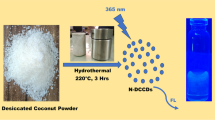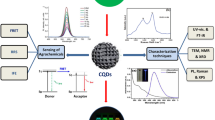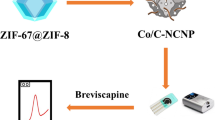Abstract
A novel ratiometric electrochemical sensor was developed based on a carbon cloth electrodeposited with silver nanoparticles and drop-coated by covalent organic framework (COF-LZU1) for simultaneous determination of bisphenol A (BPA) and bisphenol S (BPS). Carbon cloth exhibited a significantly larger electrochemical active area than common glassy carbon electrodes (27.5 times). Silver nanoparticles not only provided a stable reference signal but also enhanced electroactivity for the oxidation of BPA and BPS. COF-LZU1 with good adsorption performance and large periodic π-arrays promoted the enrichment of BPA and BPS to further increase the current response. Compared with the traditional single-signal electrochemical sensor, the developed ratiometric sensor exhibited better reproducibility and a wider linear range for BPA and BPS from 0.5 to 100 μM with a limit of detection of 0.15 μM. Furthermore, the developed sensor showed excellent stability and superior anti-interference ability. The real sample analysis for BPA and BPS has been successfully carried out in mineral water, electrolyte drink, tea, juice, and beer with recoveries of 88.3–111.7%. The developed ratiometric sensor is expected to be a candidate for the preparation of other electrochemical sensors and the analysis of additional practical samples.
Graphical abstract






Similar content being viewed by others
References
Russo G, Barbato F, Cardone E, Fattore M, Albrizio S, Grumetto L (2018) Bisphenol A and bisphenol S release in milk under household conditions from baby bottles marketed in Italy. J Environ Sci Health Part B-Pesticides Food Contam Agric Wastes 2:116–120. https://doi.org/10.1080/03601234.2017.1388662
Gallo P, Di Marco PI, Esposito F, Fasano E, Scognamiglio G, Mita GD, Cirillo T (2017) Determination of BPA, BPB, BPF, BADGE and BFDGE in canned energy drinks by molecularly imprinted polymer cleaning up and UPLC with fluorescence detection. Food Chem 220:406–412. https://doi.org/10.1016/j.foodchem.2016.10.005
Chao Z, Peisi X, Ting Y, Hailin W, Kong CAC, Zongwei C (2018) MALDI-MS imaging reveals asymmetric spatial distribution of lipid metabolites from bisphenol S-induced nephrotoxicity. Anal Chem 5:3196–3204. https://doi.org/10.1021/acs.analchem.7b04540
Nevoral J, Kolinko Y, Moravec J, Zalmanova T, Hoskova K, Prokesova S, Klein P, Ghaibour K, Hosek P, Stiavnicka M, Rimnacova H, Tonar Z, Petr J, Kralickova M (2018) Long-term exposure to very low doses of bisphenol S affects female reproduction. Reprod 1:47–57. https://doi.org/10.1530/rep-18-0092
Xiong L, Yan P, Chu M, Gao Y-Q, Li W-H, Yang X-L (2018) A rapid and simple HPLC-FLD screening method with QuEChERS as the sample treatment for the simultaneous monitoring of nine bisphenols in milk. Food Chem 244:371–377. https://doi.org/10.1016/j.foodchem.2017.10.030
Regueiro J, Wenzl T (2015) Determination of bisphenols in beverages by mixed-mode solid-phase extraction and liquid chromatography coupled to tandem mass spectrometry. J Chromatogr A 1422:230–238. https://doi.org/10.1016/j.chroma.2015.10.046
Wang Q, Zhu L, Chen M, Ma X, Wang X, Xia J (2017) Simultaneously determination of bisphenol A and its alternatives in sediment by ultrasound-assisted and solid phase extractions followed by derivatization using GC-MS. Chemosphere 169:709–715. https://doi.org/10.1016/j.chemosphere.2016.11.095
Zeng L, Zhang X, Wang X, Cheng D, Li R, Han B, Wu M, Zhuang Z, Ren A, Zhou Y, Jing T (2021) Simultaneous fluorescence determination of bisphenol A and its halogenated analogs based on a molecularly imprinted paper-based analytical device and a segment detection strategy. Biosens Bioelectron 180:113106. https://doi.org/10.1016/j.bios.2021.113106
Zhang R, Zhang Y, Deng X, Sun S, Li Y (2018) A novel dual-signal electrochemical sensor for bisphenol A determination by coupling nanoporous gold leaf and self-assembled cyclodextrin. Electrochim Acta 271:417–424. https://doi.org/10.1016/j.electacta.2018.03.113
Rao H, Zhao X, Liu X, Zhong J, Zhang Z, Zou P, Jiang Y, Wang X, Wang Y (2018) A novel molecularly imprinted electrochemical sensor based on graphene quantum dots coated on hollow nickel nanospheres with high sensitivity and selectivity for the rapid determination of bisphenol S. Biosens Bioelectron 100:341–347. https://doi.org/10.1016/j.bios.2017.09.016
Freitas JM, Ramos DLO, Sousa RMF, Paixao TRLC, Santana MHP, Munoz RAA, Richter EM (2017) A portable electrochemical method for cocaine quantification and rapid screening of common adulterants in seized samples. Sensors Actuators B-Chem 243:557–565. https://doi.org/10.1016/j.snb.2016.12.024
Li Z, Hu J, Lou Z, Zeng L, Zhu M (2021) Molecularly imprinted photoelectrochemical sensor for detecting tetrabromobisphenol A in indoor dust and water. Microchim Acta 10:1–11
Ye Z, Wang Q, Qiao J, Ye B, Li G (2019) Simultaneous detection of bisphenol A and bisphenol S with high sensitivity based on a new electrochemical sensor. J Electroanal Chem 854:113541. https://doi.org/10.1016/j.jelechem.2019.113541
Riman D, Prodromidis MI, Jirovsky D, Hrbac J (2019) Low-cost pencil graphite-based electrochemical detector for HPLC with near-coulometric efficiency. Sensors Actuators B-Chemical 296:126618. https://doi.org/10.1016/j.snb.2019.05.095
Gao X, DelaCruz S, Zhu C, Cheng S, Gardner D, Xie Y, Carraro C, Maboudian R (2019) Surface functionalization of carbon cloth with cobalt-porphyrin-based metal organic framework for enhanced electrochemical sensing. Carbon 148:64–71. https://doi.org/10.1016/j.carbon.2019.03.040
Khorablou Z, Shahdost-Fard F, Razmi H (2021) Flexible and highly sensitive methadone sensor based on gold nanoparticles/polythiophene modified carbon cloth platform. Sensors Actuators B-Chemical 344:130284. https://doi.org/10.1016/j.snb.2021.130284
Li Z, Hu J, Xiao Y, Zha Q, Zeng L, Zhu M (2021) Surfactant assisted Cr-metal organic framework for the detection of bisphenol A in dust from E-waste recycling area. Anal Chim Acta 1146:174–183. https://doi.org/10.1016/j.aca.2020.11.021
Cote AP, Benin AI, Ockwig NW, O’Keeffe M, Matzger AJ, Yaghi OM (2005) Porous, crystalline, covalent organic frameworks. Science 5751:1166–1170. https://doi.org/10.1126/science.1120411
Chen Y, Chen Z (2017) COF-1-modified magnetic nanoparticles for highly selective and efficient solid-phase microextraction of paclitaxel. Talanta 165:188–193. https://doi.org/10.1016/j.talanta.2016.12.051
Sun X, Wang N, Xie Y, Chu H, Wang Y, Wang Y (2021) In-situ anchoring bimetallic nanoparticles on covalent organic framework as an ultrasensitive electrochemical sensor for levodopa detection. Talanta 225:122072. https://doi.org/10.1016/j.talanta.2020.122072
Pang Y-H, Huang Y-Y, Wang L, Shen X-F, Wang Y-Y (2020) Determination of bisphenol A and bisphenol S by a covalent organic framework electrochemical sensor. Environ Pollut 263:114616. https://doi.org/10.1016/j.envpol.2020.114616
Huang Y-Y, Pang Y-H, Shen X-F, Jiang R, Wang Y-Y (2022) Covalent organic framework DQTP modified pencil graphite electrode for simultaneous determination of bisphenol A and bisphenol S. Talanta 236:122859. https://doi.org/10.1016/j.talanta.2021.122859
Yang J, Hu Y, Li Y (2019) Molecularly imprinted polymer-decorated signal on-off ratiometric electrochemical sensor for selective and robust dopamine detection. Biosens Bioelectron 135:224–230. https://doi.org/10.1016/j.bios.2019.03.054
Yu J, Jin H, Gui R, Wang Z, Ge F (2017) A general strategy to facilely design ratiometric electrochemical sensors in electrolyte solution by directly using a bare electrode for dual-signal sensing of analytes. Talanta 162:435–439. https://doi.org/10.1016/j.talanta.2016.10.084
Yujiao S, Xiaowen J, Hui J, Rijun G (2019) Ketjen black/ferrocene dual-doped MOFs and aptamer-coupling gold nanoparticles used as a novel ratiometric electrochemical aptasensor for vanillin detection. Anal Chim Acta 1083:101–109. https://doi.org/10.1016/j.aca.2019.07.027
Cunningham JC, Brenes NJ, Crooks RM (2014) Paper electrochemical device for detection of DNA and thrombin by target-induced conformational switching. Anal Chem 12:6166–6170. https://doi.org/10.1021/ac501438y
Wang X, Liu G, Qi Y, Yuan Y, Gao J, Luo X, Yang T (2019) Embedded Au nanoparticles-based ratiometric electrochemical sensing strategy for sensitive and reliable detection of copper ions. Anal Chem 18:12006–12013. https://doi.org/10.1021/acs.analchem.9b02945
Zhong W, Gao F, Zou J, Liu S, Li M, Gao Y, Yu Y, Wang X, Lu L (2021) MXene@Ag-based ratiometric electrochemical sensing strategy for effective detection of carbendazim in vegetable samples. Food Chem 360:130006. https://doi.org/10.1016/j.foodchem.2021.130006
Niu X, Ding S, Wang W, Xu Y, Xu Y, Chen H, Chen X (2016) Separation of small organic molecules using covalent organic frameworks-LZU1 as stationary phase by open-tubular capillary electrochromatography. J Chromatogr A 1436:109–117. https://doi.org/10.1016/j.chroma.2016.01.066
Ghazizadeh AJ, Afkhami A, Bagheri H (2018) Voltammetric determination of 4-nitrophenol using a glassy carbon electrode modified with a gold-ZnO-SiO2 nanostructure. Microchim Acta 185:296. https://doi.org/10.1007/s00604-018-2840-4
Laviron E (1974) Adsorption, autoinhibition and autocatalysis in polarography and in linear potential sweep voltammetry. J Electroanal Chem Interfacial Electrochem 3:355–393. https://doi.org/10.1016/S0022-0728(74)80448-1
Spring SA, Goggins S, Frost CG (2021) Ratiometric electrochemistry: improving the robustness, reproducibility and reliability of biosensors. Molecules 8:2130. https://doi.org/10.3390/molecules26082130
Zheng Z, Liu J, Wang M, Cao J, Li L, Wang C, Feng N (2016) Selective sensing of bisphenol A and bisphenol S on platinum/poly(diallyl dimethyl ammonium chloride)-diamond powder hybrid modified glassy carbon electrode. J Electrochem Soc 163:B192–B199. https://doi.org/10.1149/2.0281606jes
Wang X, Li M, Wu M, Shi Y, Yang J, Shan J, Liu L (2018) Simultaneous determination of bisphenol A and bisphenol S using multi-walled carbon nanotubes modified electrode. Int J Electrochem Sci 12:11906–11922. https://doi.org/10.20964/2018.12.80
Jemmeli D, Marcoccio E, Moscone D, Dridi C, Arduini F (2020) Highly sensitive paper-based electrochemical sensor for reagent free detection of bisphenol A. Talanta 216:120924. https://doi.org/10.1016/j.talanta.2020.120924
Zhang S, Shi Y, Wang J, Xiao L, Ya X, Cui R, Han Z (2020) Nanocomposites consisting of nanoporous platinum-silicon and graphene for electrochemical determination of bisphenol A. Microchimica Acta 187:241. https://doi.org/10.1007/s00604-020-4219-6
Fadillah G, Triana S, Chasanah U, Saleh TA (2020) Titania-nanorods modified carbon paste electrode for the sensitive voltammetric determination of BPA in exposed bottled water. Sensing and Bio-Sensing Research 30:100391. https://doi.org/10.1016/j.sbsr.2020.100391
Acknowledgements
This work was supported by the National Natural Science Foundation of China (21976070, 22076067) and the Fundamental Research Funds for the Central Universities (JUSRP22003).
Author information
Authors and Affiliations
Corresponding author
Ethics declarations
Competing interests
The authors declare no competing interests.
Additional information
Publisher's note
Springer Nature remains neutral with regard to jurisdictional claims in published maps and institutional affiliations.
Supplementary Information
Below is the link to the electronic supplementary material.
Rights and permissions
About this article
Cite this article
Pang, YH., Wang, YY., Shen, XF. et al. Covalent organic framework modified carbon cloth for ratiometric electrochemical sensing of bisphenol A and S. Microchim Acta 189, 189 (2022). https://doi.org/10.1007/s00604-022-05297-3
Received:
Accepted:
Published:
DOI: https://doi.org/10.1007/s00604-022-05297-3




